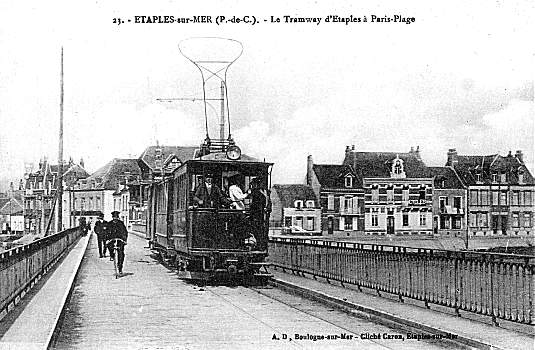

Our main postcard dates from around 1910 and shows tram 1 in Étaples-sur-Mer on the bridge over the River Canche. It was published by E.-H. Caron of 51 Rue Victor-Hugo, Boulogne-sur-Mer. As well as taking photographs, which he supplied to other card publishers as well as publishing himself (often identified by the initials H.C. or E.H.C), Caron also produced a "Post Card Guide to Le Touquet-Paris-Plage" which included among other things a timetable and description of the tramway, the 1910 edition of which was partly used for this article.
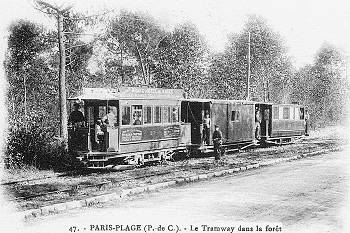 The first small view (left) shows a car in about 1905 on the passing loop in the forest about 1905, also from a Caron photograph. Note the Brill truck. The second small view (below) is a train with luggage van 23 by the rustic shelter at the Casino stop about 1910 and is a postcard by Lévy Fils et Cie, of 44 Rue Letellier, Paris. The third small view, from Cie. Alsacienne des Arts Photomécaniques of Strasbourg, shows a train including an open sided trailer passing the two lighthouses at the edge of Paris-Plage around 1918. The final small view is the 1907 station building at the terminus in Rue de Paris and shows luggage van 22 with the tram doing some shunting. This is from a postcard published around 1910 by Éditions Stevenard of Boulogne-sur-Mer, but is posted in July 1917 by a British soldier and has had the location obliterated by the censor.
The first small view (left) shows a car in about 1905 on the passing loop in the forest about 1905, also from a Caron photograph. Note the Brill truck. The second small view (below) is a train with luggage van 23 by the rustic shelter at the Casino stop about 1910 and is a postcard by Lévy Fils et Cie, of 44 Rue Letellier, Paris. The third small view, from Cie. Alsacienne des Arts Photomécaniques of Strasbourg, shows a train including an open sided trailer passing the two lighthouses at the edge of Paris-Plage around 1918. The final small view is the 1907 station building at the terminus in Rue de Paris and shows luggage van 22 with the tram doing some shunting. This is from a postcard published around 1910 by Éditions Stevenard of Boulogne-sur-Mer, but is posted in July 1917 by a British soldier and has had the location obliterated by the censor.
In the late 19th century Paris-Plage (Paris Beach) on the Côte d'Opale near the small village of Le Touquet in the historic Artois area of Pas-de-Calais, Northern France, became a popular seaside resort for Parisians. Around 1910 the area was renamed Le Touquet-Paris-Plage, today usually called just Le Touquet. To gain access to the beach, a metre gauge single track electric tramway was built to the nearest Compagnie du Nord main line railway station, which was six kilometres away at Étaples-sur-Mer. After proposals for a horse tramway, the concession for an electric line was granted to Charles Prévost and the Compagnie du Tramway d'Étaples à Paris-Plage was formed to build and operate the line, which opened on 15th July 1900.
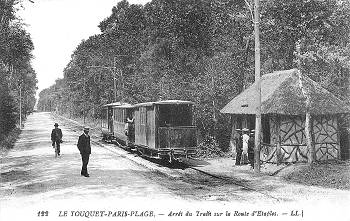 Starting at the railway station forecourt where there was an interchange and brick station building, the tramway ran in the streets of Étaples on 36kg/m Broca rails, passing the Market Place and crossing the River Canche by a 280 metre long road bridge. It then took to roadside running on 18kg/m Vignole rails through the Forest of Le Touquet. There was a halt and passing loop close by the edge of the golf course and its hotel and a second halt with a rustic shelter giving access to the Casino.
Starting at the railway station forecourt where there was an interchange and brick station building, the tramway ran in the streets of Étaples on 36kg/m Broca rails, passing the Market Place and crossing the River Canche by a 280 metre long road bridge. It then took to roadside running on 18kg/m Vignole rails through the Forest of Le Touquet. There was a halt and passing loop close by the edge of the golf course and its hotel and a second halt with a rustic shelter giving access to the Casino.
On reaching Paris-Plage and its two lighthouses built in 1846, it regained the streets at Avenue Louis Hubert, before turning south at Rue de la Lune and running along the Rue de Paris to its terminus close to what is now Rue Jean Monnet where there was a small brick station building, replaced around 1907 by a more elaborate structure.
The depots, workshops and generating station, the buildings of which still exist, were at Trépied near Étaples. At the date of opening the fares were 60 centimes first class and 50 centimes second class for the 25 minute one-way journey. The maximum gradient was 3.6 per cent and the tightest curve was 20 metre radius.
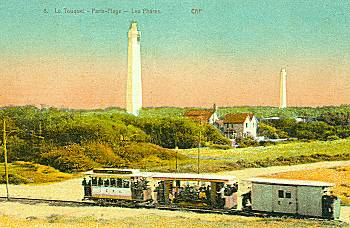 There were seven 4-wheel trams (numbered 1-7), built by Société Alsacienne de Construction Mécaniques on Brill 21E trucks and with electrical equipment by Thomson-Houston. They were fitted with bow current collectors working at 600 volt DC. Three were delivered in 1900 for the opening and four similar cars but with a five side windows instead of six were added a little later. There were 12 passenger trailers, some open sided (left) but mostly closed, and four luggage vans (fourgons). The trams carried the letters "E P" on their sides.
There were seven 4-wheel trams (numbered 1-7), built by Société Alsacienne de Construction Mécaniques on Brill 21E trucks and with electrical equipment by Thomson-Houston. They were fitted with bow current collectors working at 600 volt DC. Three were delivered in 1900 for the opening and four similar cars but with a five side windows instead of six were added a little later. There were 12 passenger trailers, some open sided (left) but mostly closed, and four luggage vans (fourgons). The trams carried the letters "E P" on their sides.
The service on the tramway was extremely seasonal with far fewer cars in the winter. From year to year the frequency varied a little, but the timetable for 1910 is a typical example. The off-peak June service up to 24th was 15 runs each way per day. The winter service would have been less. However in the peak 25th June - mid September holiday season there were 24 runs each way, with an extra run on Tuesdays and Fridays (market day in Étaples) and on weekends and feast days. Some trams connected with the trains in and would wait up to 10 minutes if they were late. In the high season the first car left Étaples at 5.15 in the morning and the last left Paris-Plage at 12.50 at night, arriving back at Étaples at 1.15. The timetable shows that not all trams had the luggage van attached, but most did and would carry up to 30 kilos of luggage free of charge (20 kilos for children who paid half fare) and then 10 centimes per each additional 10 kilos with a 25 centimes minimum.
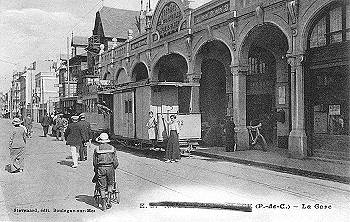 During the Great War the tramway operated a near normal service, partly due to the presence of a major British Army base at Étaples. In 1926 the river bridge was rebuilt in concrete a little downstream from the original, requiring a slight route deviation. By the end of the 1920s the tramway was losing traffic to motorbuses. From 1936 the tramway company ran buses themselves, with the winter service being run completely by buses, as was over half of the summer service. For 1937 and 1938 tram operation was limited just to the peak holiday season of July and August. The year 1939 saw a return to tram traffic as the buses were requisitioned for the French army. However this was short lived as the tramway was to close in spring 1940 due to the German occupation and was never used for public service again. The Germans employed the line to carry materials for coastal fortifications in 1942, and in 1943 the tramway was used to carry workers for German projects, probably also carrying the odd civilian. After the war the tramway never reopened and was formally declassified in 1953.
During the Great War the tramway operated a near normal service, partly due to the presence of a major British Army base at Étaples. In 1926 the river bridge was rebuilt in concrete a little downstream from the original, requiring a slight route deviation. By the end of the 1920s the tramway was losing traffic to motorbuses. From 1936 the tramway company ran buses themselves, with the winter service being run completely by buses, as was over half of the summer service. For 1937 and 1938 tram operation was limited just to the peak holiday season of July and August. The year 1939 saw a return to tram traffic as the buses were requisitioned for the French army. However this was short lived as the tramway was to close in spring 1940 due to the German occupation and was never used for public service again. The Germans employed the line to carry materials for coastal fortifications in 1942, and in 1943 the tramway was used to carry workers for German projects, probably also carrying the odd civilian. After the war the tramway never reopened and was formally declassified in 1953.
The town of Paris-Plage also was served by two 60cm gauge local tramway routes and a metre gauge steam railway from Berck-Plage, (see Postcard).
![]() Go to Postcard Of The Month Index
Go to Postcard Of The Month Index